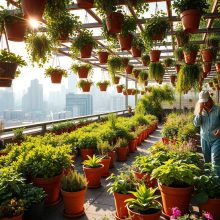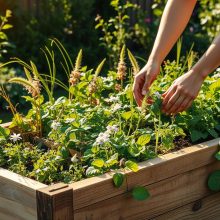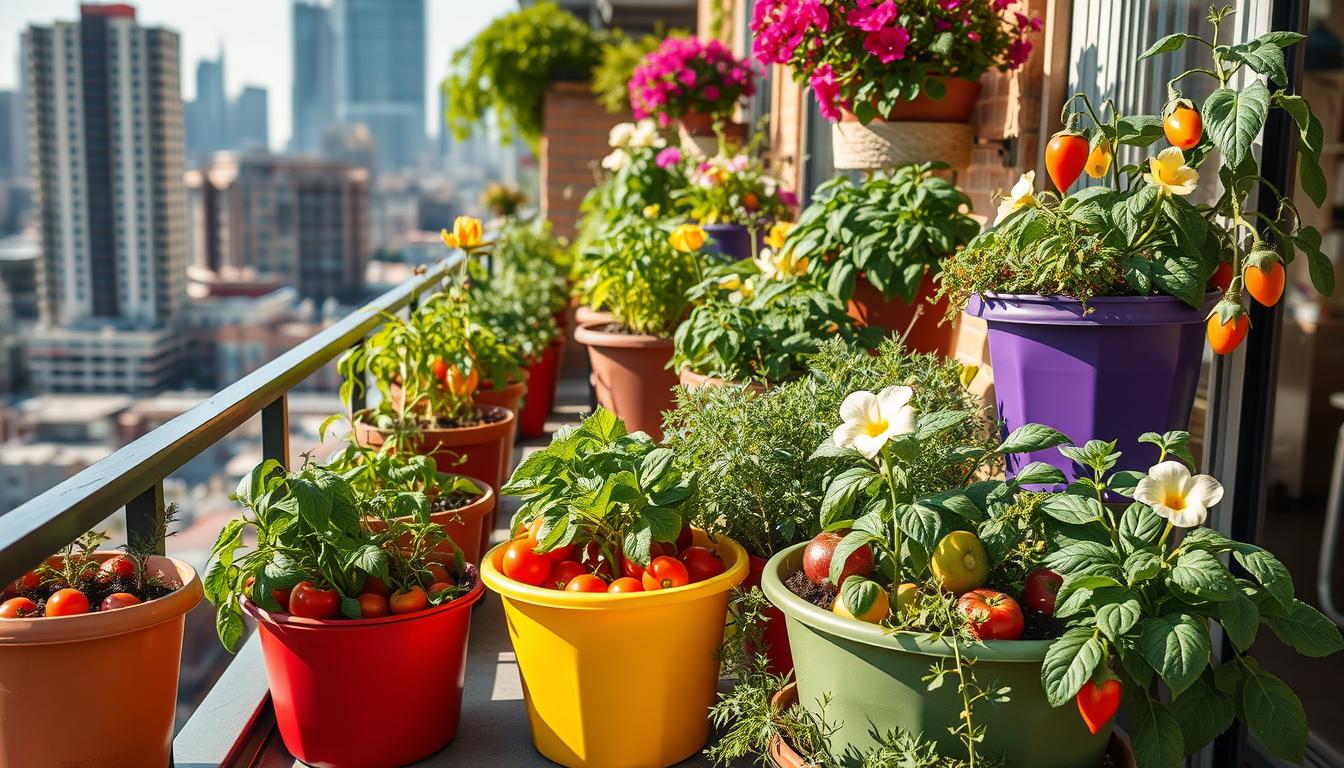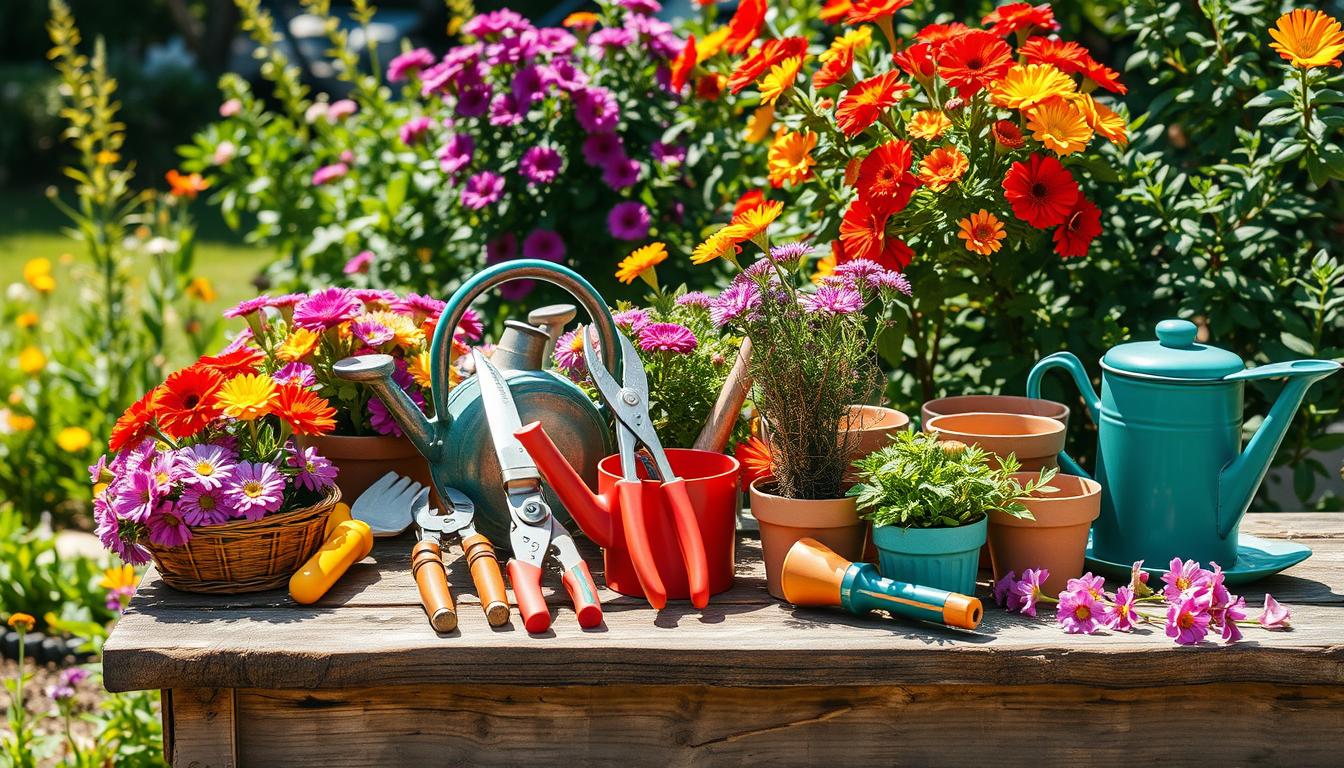Container Gardening: A Complete Guide for Beginners
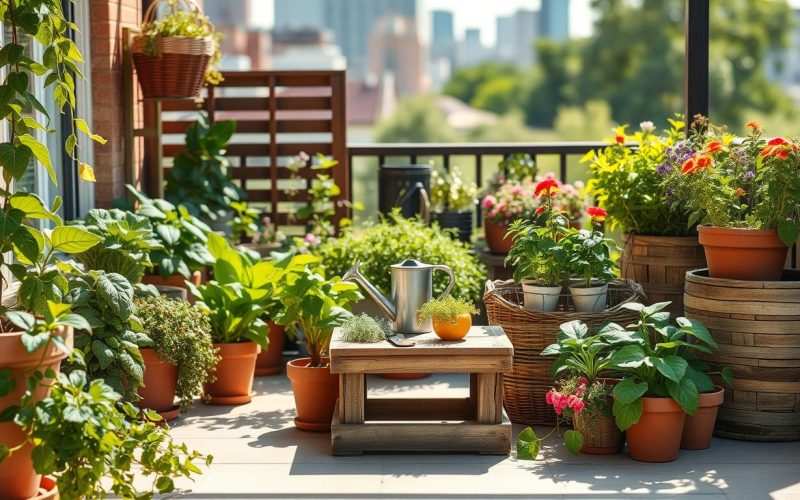
Urban farming has changed how city folks grow plants. Container gardening is a great way for those with little outdoor space to grow plants. It lets anyone grow fresh food and beautiful plants, no matter where they live.
Container gardening isn’t just a trend; it’s a smart way to garden for today’s busy lives. You can grow everything from herbs and veggies to gorgeous flowers in containers. This guide will teach you all about container gardening.
Key Takeaways
- Container gardening works in small spaces
- Multiple plant types can thrive in containers
- Urban environments are perfect for container gardening
- Minimal gardening experience is required
- Containers offer flexibility in plant cultivation
Introduction to Container Gardening
Container gardening is a great way for plant lovers to grow plants, even with little outdoor space. You can grow everything from colorful herbs to stunning flowers in small containers. It’s perfect for both small apartments and big backyards, offering endless creativity in gardening.
Benefits of Container Gardening
Container gardening has many perks for gardeners of all levels. Here are some key benefits:
- Complete control over soil quality
- Mobility to move plants as needed
- Ideal for small spaces like balconies and patios
- Reduced risk of soil-borne diseases
- Easy management of hydroponic systems
Ideal Plants for Containers
Some plants do really well in containers. Herb gardens are a top choice. Here are some favorites:
- Basil
- Mint
- Rosemary
- Thyme
- Chives
Container Gardening vs. Traditional Gardening
Container gardening is very different from traditional gardening. Traditional gardening needs a lot of ground prep. But container gardening lets you control growing conditions better. You can change soil, drainage, and nutrients easily.
Hydroponic systems take it a step further. They let plants grow in water, not soil. This means plants get nutrients directly from the water.
Choosing the Right Containers
Container gardening lets you grow plants in small spaces. Picking the right vegetable planters is key. The right one can make gardening fun, whether you’re starting seeds or growing a full garden.
Material Options for Containers
There are many materials for containers, each with its own benefits. Here are the best ones:
- Plastic: Lightweight, affordable, and easy to move
- Ceramic: Attractive and keeps roots warm
- Terra cotta: Soil can breathe but needs more water
- Fabric containers: Great for roots and air pruning
- Wooden planters: Natural look and keeps roots warm
Size Considerations for Containers
Choosing the right size is key for vegetable planters. Big veggies like tomatoes need deep containers. Smaller plants like herbs can do well in smaller seed starters. Think about how big your plants will get when picking a container size.
Ensuring Proper Drainage
Good drainage is vital for healthy plants. Look for containers with holes at the bottom. If your container doesn’t have holes, you can drill them. Adding small stones or broken pottery at the bottom helps water flow and prevents soil blockage.
Pro tip: Choose containers that fit your plants’ needs. Some veggies need more space, while others do well in small seed starters. Try different containers to see what works best for your garden.
Selecting Quality Soil
Container gardening needs careful soil selection. Garden soil is not good for potted plants because it can get too wet and hard. It can also bring diseases. Experts say to use special potting mixes for better plant growth.
Soil-less cultivation has changed container gardening for the better. It offers mixes that drain well, breathe, and hold nutrients better than regular garden soil.
Types of Potting Mix
- Peat-based potting mixes
- Coco coir blends
- Bark-based substrates
- Vermiculite and perlite combinations
Importance of Aeration
Good soil aeration is key for healthy roots. Nutrients absorb better in well-aerated soil. Light potting mixes with perlite or vermiculite are best for roots.
Organic vs. Conventional Soil
- Organic mixes use natural components
- Conventional mixes often include synthetic fertilizers
- Organic options support sustainable gardening practices
- Conventional mixes provide precise nutrient control
Pick potting mixes that fit your plants and gardening style. Knowing about soil helps make your container garden grow strong and healthy.
Essential Tools for Container Gardening
Container gardening is more than just plants and soil. The right tools make gardening easier and more fun. You’ll need everything from basic hand tools to special equipment to care for your garden.
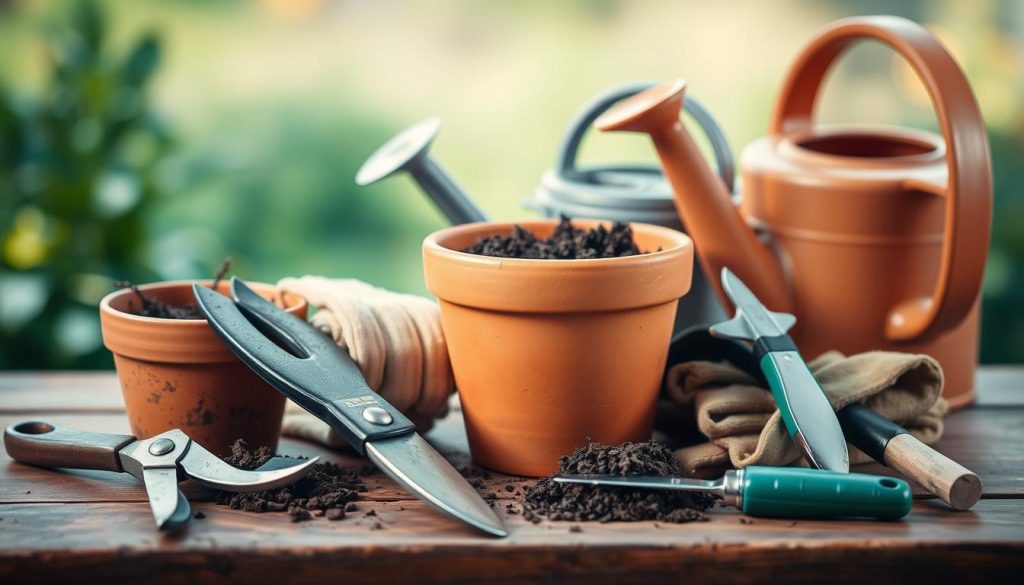
Every gardener needs a few key tools. These tools help keep plants healthy and control their growth. They also keep your garden in top shape.
Recommended Gardening Tools
- Stainless steel trowel for precise planting
- Garden clippers for pruning
- Moisture meter to track humidity control
- Lightweight garden hose for watering
- Leather gardening gloves for protection
Importance of Hand Tools
Hand tools are essential for container gardening. A good hori hori knife can do many jobs, like digging and cutting roots. Micro clip pruners help shape plants and remove bad parts with care.
Additional Accessories for Success
Indoor gardeners should get grow lights for extra sunlight. These lights make sure plants get enough light, even in dark places. Use them with a humidity control system for the best growing conditions.
- LED grow lights for indoor gardens
- Digital hygrometer for tracking moisture
- Adjustable plant stands
- Portable humidity controllers
Choosing the right tools and accessories will help your container garden thrive. You’ll get healthy, vibrant plants.
Location and Placement
Finding the perfect spot for your indoor garden is key to plant health and growth. The right spot helps your plants thrive. Knowing what plants need in terms of placement is crucial for a great garden.
Sunlight Requirements for Healthy Plants
Every plant needs different amounts of sunlight to grow well indoors. Here are some important points:
- Full sun plants need 6-8 hours of direct sunlight a day
- Partial shade plants require 3-5 hours of filtered light
- Low-light plants can manage with little direct sunlight
Wind Protection Strategies
Keeping plants safe from strong winds is important. Here are ways to protect them:
- Put containers near walls or fences
- Use windbreak screens
- Group containers for mutual protection
Creative Container Arrangements
Indoor gardening can be more than just placing plants. Try vertical gardens, hanging planters, and tiered setups. These can make your space look great and ensure your plants get the best conditions.
Watering Practices for Containers
Container gardening has its own set of challenges when it comes to watering. Potted plants need more care because they have less soil and are more exposed to the environment.
Understanding Water Needs
Keeping plants healthy in containers requires good humidity control. The water needs of plants vary based on several factors:
- Plant species and growth stage
- Container material and size
- Local climate conditions
- Sunlight exposure
Identifying Watering Frequency
Most container plants need water when the top inch of soil feels dry. In summer, this might mean watering once or twice a day. You can check moisture by feeling the soil or using a moisture meter.
Avoiding Overwatering Risks
Too much water can harm plants as much as too little. Look out for these signs:
- Yellowing leaves
- Wilting despite moist soil
- Fungus growth on soil surface
- Root rot symptoms
Best Watering Techniques
Use smart watering methods to keep plants healthy. Water deeply but not too often. Make sure there are drainage holes to let excess water out. Consider using self-watering containers or special soil mixes to help with humidity and reduce watering.
Fertilizing Container Plants
Container gardening has its own set of challenges when it comes to feeding plants. Unlike regular gardens, container plants get all their nutrients from a small amount of soil. Water flows quickly through containers, washing away important nutrients. This means you need to fertilize carefully and often.
Knowing how to fertilize right can make your container garden flourish. Healthy nutrients are key for strong growth, bright colors, and plenty of harvests.
Types of Fertilizers
- Slow-release granular fertilizers
- Liquid fertilizers
- Water-soluble plant nutrient mixes
- Organic compost-based nutrients
Timing for Fertilization
For a successful container garden, timing your fertilization is crucial. Most plants do well with regular feeding when they’re actively growing. Vegetables and flowers usually need it every 2-4 weeks during the growing season.
Organic Fertilizing Options
- Compost tea
- Worm castings
- Fish emulsion
- Seaweed extract
Organic nutrients are a gentle, eco-friendly way to feed your plants. They not only feed your plants but also make the soil better and help with good microbes.
Seasonal Planning for Container Gardening
Container gardening needs careful planning all year to help plants grow well. Knowing what each season brings helps gardeners make their gardens thrive. This way, they can handle changes in the weather.
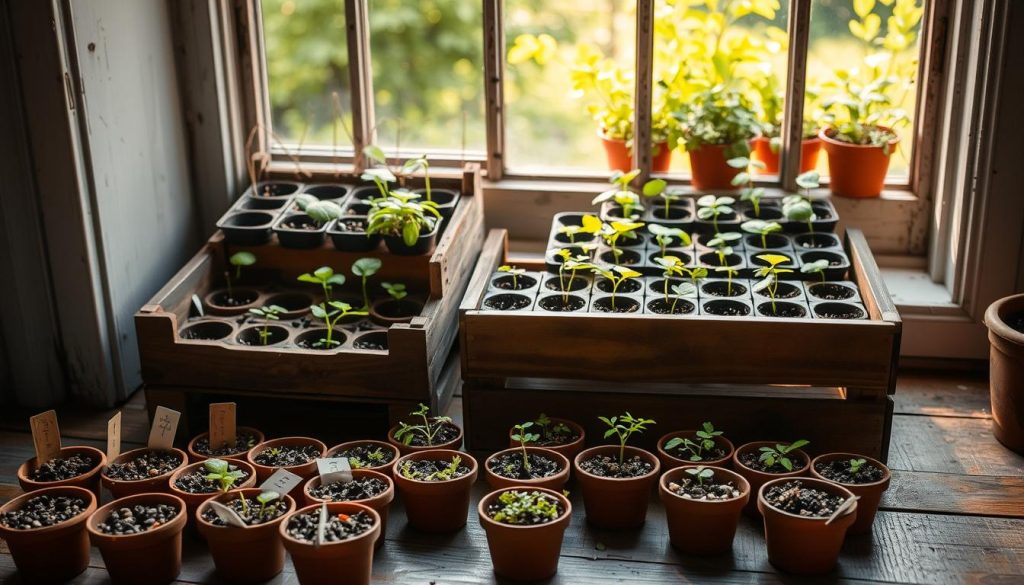
For a successful container garden, timing is key. Choose the right plants for the season. This means picking ones that like the temperature and light of each time of year.
Spring Planting Tips
Spring is the best time to start your container garden. Here’s what to do:
- Choose plants that can handle cold
- Start seeds indoors 6-8 weeks before it gets too cold
- Use trays with good drainage for seeds
- Keep the soil at a steady temperature
Summer Maintenance Strategies
Summer is hot and can be dry. Your garden needs extra care. Here’s how to keep it going:
- Water more often
- Give plants shade in the afternoon
- Check the soil moisture
- Use mulch to keep it moist
Fall Planting Suggestions
Fall is great for container gardening with cooler crops. Here’s how to make the most of it:
- Plant root vegetables
- Move seed starters to cooler places
- Get your containers ready for winter
- Choose plants that can handle cold
Understanding the seasons helps gardeners make their container gardens grow all year. This way, they can enjoy a productive garden every season.
Pest and Disease Management
Container gardening has its perks when it comes to keeping plants healthy. Unlike traditional gardens, container gardens are easier to control. Hydroponic systems make it even simpler to avoid common problems.
Knowing how to manage pests is key to keeping your plants in top shape. There are many ways to keep your plants safe from harm.
Common Pests in Container Gardens
Container gardens can attract pests. Some of the most common ones are:
- Aphids
- Spider mites
- Whiteflies
- Fungus gnats
- Mealybugs
Organic Pest Control Methods
There are natural ways to fight pests in hydroponic systems and container gardens:
- Neem oil spray
- Insecticidal soaps
- Beneficial insects like ladybugs
- Companion planting
- Regular plant inspection
Recognizing Plant Diseases
Spotting diseases early is crucial. Look for signs like discolored leaves, wilting, or odd growth. Hydroponic systems help by keeping growing conditions clean and controlled.
Keeping your plants healthy means regular care and watching them closely. It also means being ready to act fast when needed.
Harvesting from Container Gardens
Growing veggies in container gardens is very rewarding. It’s perfect for city dwellers and those with little space. You can turn patios, balconies, and small areas into gardens that produce fresh food.
To harvest successfully, you need to pay attention and use the right methods. Your container garden can give you lots of food if you know when and how to pick it.
Timing Your Harvest
It’s important to know when to pick your veggies for the best taste and nutrition. Each type of vegetable has its own sign of being ready:
- Tomatoes: Pick when fully colored and slightly soft
- Lettuce: Harvest outer leaves while allowing center to continue growing
- Peppers: Cut when they reach desired size and color
- Herbs: Trim before flowering for best taste
Harvesting Without Damage
When you’re harvesting, be gentle. Use clean, sharp scissors or pruning shears. Don’t pull or twist, as it can hurt the plant’s roots.
Continuing Growth After Harvest
Many plants in container gardens can give you more than one harvest. Leafy greens, herbs, and some veggies will grow back if you harvest them right. Regular pruning helps your garden keep growing and producing food all season.
Putting your vegetable planters near a back door or kitchen makes harvesting easy. It also encourages you to take care of and enjoy your garden more often.
Container Gardening for Limited Spaces
Urban farming has changed how city folks garden. Even with small spaces, you can grow fresh food and plants. Container gardening is a great way to garden in tight spots.
To turn small areas into green spaces, you need creativity and planning. Urban gardeners can make balconies, patios, and windowsills into lively gardens. This turns small spaces into productive areas.
Urban Gardening Techniques
- Select compact plant varieties suited for containers
- Use lightweight, portable growing containers
- Implement space-saving gardening methods
- Optimize sunlight exposure for urban gardens
Vertical Gardening Solutions
Vertical gardening opens up new space in cities. Gardeners can use:
- Wall-mounted planters
- Hanging basket systems
- Stackable container units
- Trellis and climbing plant arrangements
Balcony and Patio Ideas
Urban farming gets creative with container placement. Balconies and patios can become green spaces. Try growing herbs, tomatoes, and decorative veggies in these spots.
With careful planning, you can make your small space a lush garden. It’s a great way to enjoy nature in the city.
Creative Container Ideas
Container gardening lets you get creative with plants. You can turn everyday items into unique planters. This adds a personal touch to your herb garden.
Utilizing Recycled Materials
Start by using old items as planters. This is good for the planet and saves money. Here are some ideas:
- Vintage metal buckets with drainage holes
- Old wooden crates or wine boxes
- Ceramic teapots and unique kitchen containers
- Retired kitchen colanders
- Worn-out boots or rubber gardening shoes
Unique Container Choices
Choosing the right container makes your herb garden stand out. Look for items that fit your space and plant needs. Try using galvanized metal tubs, copper planters, and hanging baskets.
Painting and Personalizing Containers
Make your containers your own with paint and decorations. Use outdoor paints that won’t fade. Add stencils, decoupage, or mosaics to make them special.
- Choose exterior acrylic paints for durability
- Seal painted containers with clear waterproof sealant
- Experiment with color blocking and geometric patterns
Troubleshooting Common Issues
Container gardening comes with its own set of challenges. It’s important to know how to handle these issues to keep plants healthy. This is true whether you’re using traditional or new soil-less methods.
Plant health depends on many things. This includes the right food, enough light, and the right container. Gardeners need to be ready to solve problems fast to avoid lasting damage.
Growth Problems in Container Gardens
Some common growth issues in container gardens are:
- Stunted plant development
- Yellowing leaves
- Weak stem structures
- Slow or inconsistent growth patterns
Grow lights can help a lot in low-light areas. They give plants the light they need to grow strong and healthy.
Solutions for Nutrient Deficiencies
Nutrient problems show up differently in container gardens. Here are some ways to fix them:
- Regular soil testing
- Using balanced, slow-release fertilizers
- Rotating nutrient supplements
- Monitoring plant color and leaf health
Addressing Container Size Issues
Choosing the right container size is key for plant success. Soil-less cultivation offers space-saving solutions. It lets gardeners grow plants in flexible, lighter environments with better root growth.
By learning these troubleshooting tips, container gardeners can grow healthier, more productive plants.
Resources for Further Learning
There’s more to learn about indoor gardening than this guide covers. The world of container gardening is vast and full of opportunities. If you’re passionate about gardening, there are many resources to help you grow and connect with others.
Books by experts like Sharon Lahr and Mel Bartholomew are full of valuable insights. They share detailed strategies for growing plants in containers. Websites like Gardener’s Supply Company and Garden.org also have lots of digital resources, tutorials, and forums. Here, gardeners can share their experiences and get help solving problems.
Local gardening clubs and workshops are great for learning by doing. Many places like community centers, botanical gardens, and agricultural offices have sessions on container gardening. These sessions let you learn hands-on, meet experts, and find out what works best in your area.
Digital communities have changed how we connect with other plant lovers. Sites like Reddit’s r/gardening and Facebook groups are perfect for asking questions and sharing tips. By always learning, your indoor gardening skills will keep getting better.
